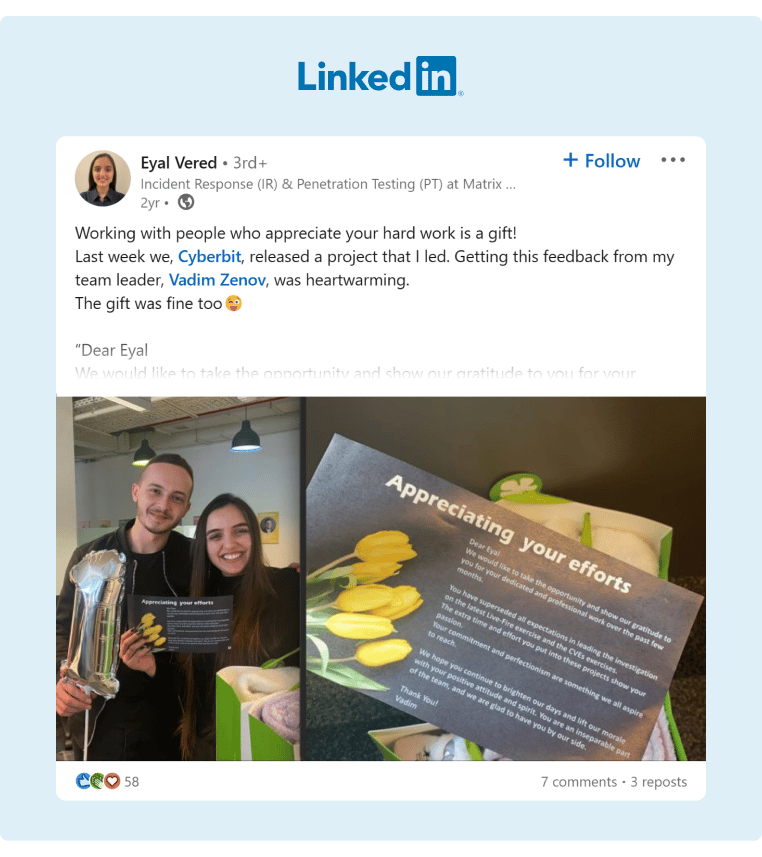Why Your Brand Needs Employee-Generated Content
For digital marketers, content is king. It’s the foundation of their marketing strategies. They use content to boost brand awareness, foster engagement, and build trust, which in turn, generates leads and attracts top talent.
But, consistently curating content and creating original content can be taxing when your brand has multiple social platforms and limited resources. This is why your digital marketing strategy needs to include employee-generated content (EGC) as part of your content marketing strategy.
In this article, we’ll explain what employee-generated content is, why your brand needs it, the benefits, and how to integrate it into your digital marketing strategy.
What Is Employee-Generated Content (EGC)?
Employee-generated content is content (blogs, videos, images, social media posts) created and shared by your team. Your employees act as storytellers and educators, giving a peek into what it’s like to work for your brand plus their perspective on other industry-related topics.
For example, a B2B tech company sells small business phone systems. A member of its development team writes an article addressing common pain points consumers experience with phone network systems.
In the article, they mention how their product alleviates these issues. This example of employee-generated content educates readers while highlighting the strengths of the company’s own service.
In addition to articles, other forms of employee-generated content include:
-
Blogs. Articles and thought leadership pieces hosted on your company’s website or guest-written for relevant industry sites.
- Social Media Posts. Content shared on social media platforms (LinkedIn, Facebook, TikTok, Instagram).

Source: Kara Kennedy
-
Images and Videos. Behind-the-scenes peek into product launches, office life, etc.
-
Employee Spotlights. Highlight your employees and their achievements.
-
Employee Testimonials and Company Reviews. Employees share what it is like to work for your company. These can be posted on your website, LinkedIn company page, or review sites like Glassdoor.

Source: Yuliya B.
-
Internal Newsletters. Company updates and highlights from employees.
-
Bulletin Boards. Virtual or physical boards featuring employee contributions.
How Employee-Generated Content Boosts Marketing Campaigns
The best B2B marketing strategies include content marketing, so there’s a lot you stand to gain from employee-generated content.
Let’s go over some of the key benefits.
Builds Authenticity and Trust in Your Brand
Employee-generated content offers a level of authenticity that corporate forms of marketing just can’t match. Employees are seen as:
- Informed about their brand and/or industry.
- Closer to the average consumer than C-suite executives.
- More honest due to having less of a stake in the business.
Some businesses require their employees to be private when it comes to discussing their working lives. This breeds distrust among consumers and potential candidates because they wonder what the brand is hiding.
Employee-generated content shows your audience you aren’t afraid to let your employees talk about their day-to-day work experiences. By offering a behind-the-scenes look, it’s easier for people to trust your brand because you’re being transparent.

Source: Sobhi Smat
Enhances Brand Advocacy and Boosts Employee Engagement
Brand advocacy is a strategy that uses brand advocates to elevate a brand through word-of-mouth. In this case, your brand advocates are your employees.
Investing in employee-generated content is a great way to boost employee engagement and start reaping those employee advocacy benefits. The best employee content is when they’re allowed to speak earnestly.
Employee-generated content gives your staff a voice, which makes them invested. They also appreciate that you trust them with the task of being a brand advocate, boosting employee morale and motivation.
It also gives your employees a greater stake in marketing success. They aren’t just churning out faceless ad campaigns. They’re taking on roles as recognizable brand advocates and ambassadors for your brand.
 Source: Eyal Vered
Source: Eyal Vered
Expands Social Media Reach Through Employee Networks
When you amplify employee-generated content with employee advocacy, you expand your brand’s social media reach.
A major benefit of employee advocacy is the increase in brand awareness. For example, your company page has 5,000 followers, and you have 10 employees with 1,000 connections each. So, the combined networks’ potential reach is 10,000.
Now let’s say one of your employees writes an article about application portfolio management with Ardoq. They share the article on their personal LinkedIn page where their colleagues reshare it, your company reshares it, and so on.
A few degrees of separation later, one of Ardoq’s senior leaders sees it. They appreciate your employee’s insights. Just like that, you’ve established positive relations with another business and boosted your brand awareness with other potential customers.
Attracts Top Talent With Genuine Workplace Portrayals
Employee-generated content isn’t just for generating potential leads. It’s also excellent for attracting top talent.
When you consider applying to and accepting a job with a new employer, you’re facing a lot of unknowns. It’s hard to know what it’s like working somewhere without actually experiencing the role and work environment. There might be a toxic work culture lurking under that veneer of advertised professionalism.
Employee-generated content offers transparency, which can alleviate these concerns. First-hand insights from an actual employee can tell you a lot more than any job listing or vaguely worded recruitment ad.
In industries where salaries and benefits are competitive, such as including comprehensive health and personal insurance packages, your brand’s reputation can make all the difference. Current (and even former employees) who aren’t tapped as influencers can advocate or criticize your brand, not to mention your internal work culture, which can pose a risk.
 Source: Franch Almero
Source: Franch Almero
By not leveraging employee-generated content, you’re passing up the opportunity to control the conversation.
How To Implement EGC in Your Marketing Strategy
To maximize your content marketing strategy, we’ve put together a list of five tips for incorporating employee-generated content effectively.
1. Define Your Goals and Marketing Objectives
A solid set of marketing objectives provides vital context for all the decision-making that is to follow.
Let’s say you run a B2B tech company, and you’re trying to promote your sales enablement tool. You might come up with the following goals:
- Increase landing page CTR by 50% by Q2.
- Boost social media reach by 60% by Q3.
- Publish two new pieces of promotional content every week.
- Double the average monthly number of demo calls by Q3.
Now you have a plan in place (e.g., create two new pieces of promotional content weekly) and metrics to track how those pieces of content are performing.
2. Identify and Empower Content Contributors
To leverage the power of employee influencers, identify and select who will be content contributors.
One of the major criticisms of employee-generated content is that most people don’t happen to be skilled actors, writers, or public speakers. Identifying the best content contributors means finding your most articulate employees who embody the ideals of your company culture and brand. These people will serve as your main brand ambassadors.
You can also coordinate with them on content featuring other employees to give non-content creators a voice. For example, a designated employee influencer might lead a series of interviews with colleagues to offer insights into daily working life.
 Source: Natalie Taylor
Source: Natalie Taylor
3. Create a Detailed Marketing Content Plan
With your goals in mind and key content creators established, it’s time to craft your content marketing plan. Tasks to include are:
- Content distribution methods (social media channels, blog posts, etc).
- Timeline planning and resource allocation for content creation.
- Content promotion (external posting, hashtags, influencer promotion, etc).
- Technical optimization (SEO evaluation, CTA creation, etc).
- Data collection to improve future EGC marketing strategies.
4. Provide Tools To Facilitate the Content Creation Process
Creating high-quality content is a process. Here are some tips to help facilitate the content creation process:
- Encourage tools like a desktop time tracker to allocate time at work to create content, or an AI voice generator to support employees hesitant about recording their voice.
- Offer access to knowledge base materials.
- Connect employee influencers to colleagues using collaboration and communications tools like Slack or Microsoft Teams direct routing.
- Provide branded design assets for that professional touch.
- Allocate resources to content creation (such as by funding the creation of a video series).
- Provide content channels such as your company blog or social media.
Lending genuine support to your content creator employees shows a genuine commitment to giving employees a voice. It also helps to ensure employee content has the measure of polish and presentation you’d expect from something affiliated with your brand.
5. Promote and Distribute EGC Effectively
Once your content is created, you need to promote and distribute it effectively. Using an employee advocacy platform like GaggleAMP to streamline content scheduling and distribution can help.
Teachstone is a fantastic example of a company who benefitted from having a dedicated employee advocacy platform, which positively impacted its content marketing strategy. In the first 90 days of implementing GaggleAMP, Teachstone experienced:
- Over 1,200 social media interactions.
- A 60% increase in content CTR.
- Immediate returns on direct messages in the form of new business.
Strategies on Leveraging Social Media To Amplify EGC
In addition to your content marketing strategy, you also need to consider how employee-generated content fits into your social media marketing strategy.
Here are four tips for effectively leveraging social media to amplify your employee-generated content.
1. Choose the Right Social Platforms
With so many social media platforms available, it’s important to focus on the ones that your target audience uses.
For instance, if your company offers workplace management software, your best bet is targeting prospective B2B clients on LinkedIn. Here, you can share case studies of how your product has helped other B2B companies.

2. Provide Guidelines and Templates for Consistent Brand Messaging
Brand consistency on social media is essential for building recognizability and trust. You want to ensure, no matter what social platform your audience is on, that your employee-generated content has consistent brand visuals, colors, values, tone, etc.
As part of your employee branding strategy, consider creating a brand ambassador program that nurtures potential brand ambassadors in your company. Part of the program can include hosting brand training to educate your employees on the brand’s values, vision, and goals along with the brand style guide. This ensures your employee’s content aligns with the company’s brand messaging and reputation.
 Source: John Schiess
Source: John Schiess
3. Collaborate With Influencers To Expand the Reach of EGC
Collaborating with influencers is an easy way to make your company a more credible source and to expand your brand reach. The key is to collaborate with relevant influencers who will boost your reputation, not harm it.
That’s why so many brands choose to collaborate with established influencers. These are people who can promote your content and even show off your products or services. They can also provide a foothold for your employee content creators to establish an audience.
 Source: Wesley Taylor
Source: Wesley Taylor
4. Use a Branded Hashtag To Unify Employee Content
Hashtags have been around for a long time, and for good reason. They’re an effective way of bundling content. Come up with something distinctive, and you have a memorable search term to bring up all of your EGC posts on any given platform.
 Source: Edcel Paul Tejare
Source: Edcel Paul Tejare
And that’s without even discussing the impact of community engagement. With hashtags, anyone can get involved. Provoke enough discussion and your tags can take on a life of their own.
Employee-Generated Content Is a Marketing and Engagement Strategy All-in-One
What makes employee-generated content such a powerful tool is its dual purpose. It serves as a marketing strategy by offering transparency to potential leads. People feel they can trust your brand because insights are shared by real people.
Employee-generated content works wonders for employee engagement. Employees advocate for you as an ideal employer. This brings top talent to your door, who are interested in working for your company. That, in turn, transforms new hires into your next generation of brand ambassadors.
Conversations about your brand are happening whether you facilitate them or not. Employee-generated content through employee advocacy is a way to control the narrative. And with a tool like GaggleAMP, you can streamline and amplify your advocacy efforts. Set your team up for success and schedule a demo today.











